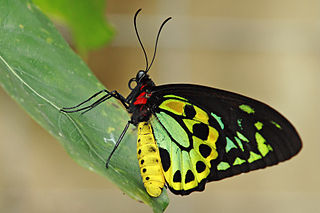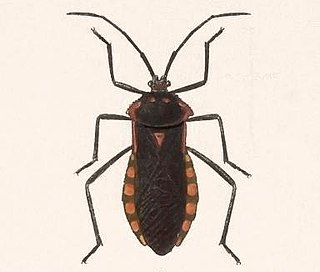
Biological databases are libraries of biological sciences, collected from scientific experiments, published literature, high-throughput experiment technology, and computational analysis. They contain information from research areas including genomics, proteomics, metabolomics, microarray gene expression, and phylogenetics. Information contained in biological databases includes gene function, structure, localization, clinical effects of mutations as well as similarities of biological sequences and structures.

Sphaerites is a genus of beetles, the only genus in the family Sphaeritidae, sometimes called the false clown beetles. There are five known species, which are widespread in temperate areas of the Northern Hemisphere, found in forested or upland areas.

Baccaurea is a genus of flowering plants belonging to the family Phyllanthaceae. The genus comprises 51 species, distributed from India to Indochina, southern China, Malesia, New Guinea, and the West Pacific. It is dioecious, with male and female flowers on separate plants. Many species contain edible fruits.

Ornithoptera euphorion, the Cairns birdwing, is a species of birdwing butterfly endemic to Queensland, and is Australia's largest endemic butterfly species. Other common names include Cooktown birdwing and northern birdwing. The names Cairns and Cooktown in its common name reference the Australian cities in the region where this butterfly is found.

Stellaria pubera, commonly called the star chickweed, is a spring-flowering plant in the carnation family Caryophyllaceae, native to the eastern United States.

Chione is a genus of American tropical marine bivalve molluscs, in the family Veneridae.
The Catalogue of Life is an online database that provides an index of known species of animals, plants, fungi, and microorganisms. It was created in 2001 as a partnership between the global Species 2000 and the American Integrated Taxonomic Information System. The Catalogue is used by research scientists, citizen scientists, educators, and policy makers. The Catalogue is also used by the Biodiversity Heritage Library, the Barcode of Life Data System, Encyclopedia of Life, and the Global Biodiversity Information Facility. The Catalogue currently compiles data from 165 peer-reviewed taxonomic databases that are maintained by specialist institutions around the world. As of September 2022, the COL Checklist lists 2,067,951 of the world's 2.2m extant species known to taxonomists on the planet at present time.

The Encyclopedia of Life (EOL) is a free, online encyclopedia intended to document all of the 1.9 million living species known to science. It aggregates content to form "pages" for every known species. Content is compiled from existing trusted databases which are curated by experts and it calls on the assistance of non-experts throughout the world. It includes video, sound, images, graphics, information on characteristics, as well as text. In addition, the Encyclopedia incorporates species-related content from the Biodiversity Heritage Library, which digitizes millions of pages of printed literature from the world's major natural history libraries. The BHL digital content is indexed with the names of organisms using taxonomic indexing software developed by the Global Names project. The EOL project was initially backed by a US$50 million funding commitment, led by the MacArthur Foundation and the Sloan Foundation, who provided US$20 million and US$5 million, respectively. The additional US$25 million came from five cornerstone institutions—the Field Museum, Harvard University, the Marine Biological Laboratory, the Missouri Botanical Garden, and the Smithsonian Institution. The project was initially led by Jim Edwards and the development team by David Patterson. Today, participating institutions and individual donors continue to support EOL through financial contributions.

Elaphropus is a genus of ground beetles in the family Carabidae. There are at least 370 described species in Elaphropus.

iNaturalist is an American 501(c)(3) nonprofit social network of naturalists, citizen scientists, and biologists built on the concept of mapping and sharing observations of biodiversity across the globe. iNaturalist may be accessed via its website or from its mobile applications. iNaturalist includes an automated species identification tool, and users further assist each other in identifying organisms from photographs and even sound recordings. As of 9 July 2024, iNaturalist users had contributed approximately 197,660,888 observations of plants, animals, fungi, and other organisms worldwide, and 290,007 users were active in the previous 30 days.
Atrichomelina is a genus of flies in the family Sciomyzidae, the marsh flies or snail-killing flies.

Rhodopina is a genus of longhorn beetles of the subfamily Lamiinae, containing the following species:
Rhodopina pubera is a species of beetle in the family Cerambycidae, and is the type species of its genus. It was described by James Thomson in 1857. It is known from India.
Tipula pubera is a species of large crane fly in the family Tipulidae.
Echthodopa formosa is a species of robber flies in the family Asilidae.
Echthodopa is a genus of robber flies in the family Asilidae. There are at least four described species in Echthodopa.

Sephina is a genus of leaf-footed bugs in the family Coreidae. There are more than 20 described species in Sephina.

Pyrularia pubera is a shrub in the sandalwood family which grows through the eastern United States from New York to Alabama, being mostly found in the Appalachian Mountains. It is commonly referred to as buffalo nut or oil nut. It grows up to 4 meters (13 ft) tall mostly in the shade of other trees. It is a parasitic plant, specifically a hemiparasite which while still photosynthetic, will also parasitize the roots of other plants around it. It can parasitize many hosts.

Pyrularia is a small genus of shrubs or small trees in the sandalwood family (Santalaceae) which contains two species, Pyrularia pubera and Pyrularia edulis. P. pubera grows in the eastern United States and P. edulis grows in Bhutan, China, India, Myanmar, and Nepal. Both species are parasitic plants, specifically hemiparasites, which while still photosynthetic, will also parasitize the roots of other plants around them.












